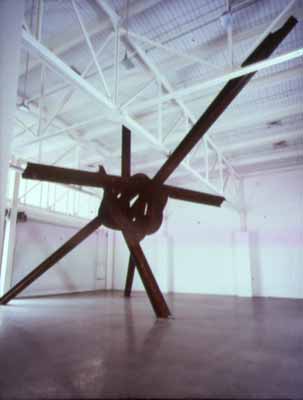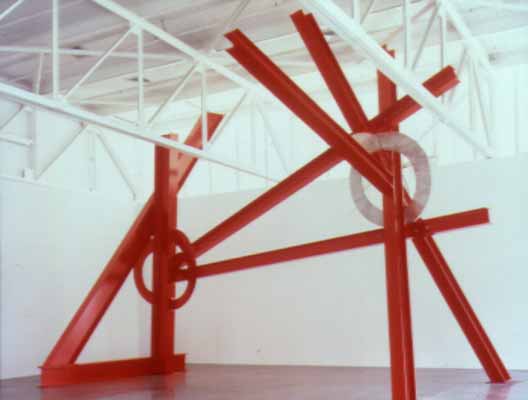
© Mark diSuvero
Evviva Amore, 2001.
Steel, 27' 6" x 46' 2" x 30'.
Photo by Robert McKeever.
Mark di Suveroby Don Goddard |
 © Mark diSuvero Evviva Amore, 2001. Steel, 27' 6" x 46' 2" x 30'. Photo by Robert McKeever. |
In Marxist terms, every part of a di Suvero sculpture has use value. Steel beams, plates, and bolts are used to create completely knowable, rational structures. It is clear how things are joined and that they are securely joined. There is no deception, no distortion or manipulation of materials, no evisceration of their power as in Carl Andre nor exaltation as in Richard Serra. Beams, plates, and bolts remain those things, and in every case they remain true to their use and to their individual existence. The metal is cut, twisted, or bent but never shaped, as in Alexander Calder, so that the required force is always evident and the metal retains its character. The steel is raw, painted, or burnished, and the latter two are seldom combined with the first, just as a tree would be unlikely to have human skin. These parts were made to be used by human beings and they bear the evidence of human and natural use: numbers and words written on the raw steel, rusting and corrosion, paint applied in primary colors as though to express some heightened human value or hope, or perhaps simply to obviate the rawness. |
| It's strange to see these big pieces cooped up inside another structure. Mostly they are sited outdoors--in landscapes like the Storm King Art Center; in cities like Paris, New York, and Stuttgart, where di Suvero has had major shows; in city sites like the Potsdamer Platz in Berlin and Bluff Park in Milwaukee; and in industrial yards where the work is made. The gallery is made (or remade in this case from an old warehouse) to enclose space and to protect the work within it. Its structure is devoted entirely to those purposes and to other practical uses. Di Suvero's purpose is, in many ways, quite the opposite, to open space rather than enclose it, to expose rather than protect. Whereas galleries are usually more or less neutral in relation to the art they show, the gallery here is like an automobile showroom in which the objects on view are really meant for an entirely different environment and have an entirely different and more complex meaning than in relation to this structurally and culturally specialized setting. Particularly in view of the nature of di Suvero's work, this exhibition places in question the very idea of showing work, but the work itself justifies its showing in any way possible, given that it carries everything within itself. |
| Still, the enclosure is limiting. The ends of I-beams thrusting upward become entangled with the crossbeams of the ceiling. Di Suvero's monumental works are coordinates to things outside themselves, and here it's like trying to fix a position with a sextant without being able to see the stars. Both of the big works are exclamations, the red one titled Ulalu (the Italian version of a wolf's howl) and the raw brown one Evviva Amore ("Long Live Love" in Italian), but the exclamation is contained by the gallery structure and cannot be heard, or seen, over a distance. Though the natural thrust of these works is outward, from the earth to unimaginably distance points, they are nonetheless figures, rooted in the earth and defined by their materiality and the extent of their reach. They stand on legs and seem to have arms or branches, all of which intersect in circular joints, hearts, brains. They embody a kind of magnificent stasis, firmly planted and immovable, and yet it is impossible to really know that without seeing them from every vantage point, without accumulating views and keeping the composite stored somewhere. It is simply that their references to a larger world or universe are truncated. |
|
|
| The smaller pieces in the exhibition -- Rudder and Besprangle -- paradoxically cannot be truncated; they are self-contained and exist within human dimension. Their size brings them within our own compass, like our own brains or consciousness. Motion takes place within them, one element turning on another, rather than in thrusts outward and around. All references are inward, through reflections in mirror surfaces, twistings of steel into knots, steel sheets cut to represent positive and negative shapes bound together. All of Di Suvero's table or pedestal pieces are raw metal configurations of shapes that seem to derive from the same source, a single flat sheet of steel. These are the organic counterparts, the seeds -- appearing sometimes as moral consciences -- of his more-than-lifesize constructions. Donald Goddard © 2001 |

Magazine - Art Reviews Listings - Previous Review - Next Review
Art Review - NYArtWorld.com - NYAW.com. All artwork is copyright of the respective owner or artist. All other material © Copyright 2015 New York Art World ®. All Rights Reserved.
New York Art World ® - Back to Top